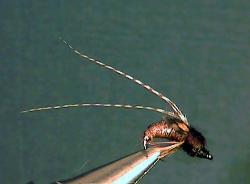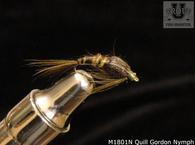
As with most other caddisflies, the main problem you face is determining when the hatch is taking place. When you see adult cinnamon caddis around the stream, flying and in the trees, grass and bushes, you don't necessarily know if they just hatched on hatched a few days earlier. Some stay out of the water for a few days before they deposit their eggs. Even when you see them on the water and darting down to the water, it doesn't necessarily mean they are laying eggs. They will do that before they deposit their eggs on occasions.
Often the caddisflies are emerging at the same time they are depositing their eggs. Again, just seeing adults around the water doesn't tell you that the caddis are hatching at that time. The single biggest mistake I see anglers make fishing caddisfly hatches is they don't have flies to match the emerging pupa. They only have adult imitations, usually just Elk Hair Caddis which don't imitate many species of them very well at that. In other words, they overlook fishing the best and most productive part of the hatch.
The Cinnamon Cadisfly pupae swim to the surface to hatch. They are very available for the trout to eat at that time. They are completely defenseless. This is the best time to imitate the Cinnamon Caddis and you will want to use an emerger imitation, not an adult. They emerging caddis don't look anything like the adults as you can see from our Perfect Fly Cinnamon Caddis Emerger fly below.
Unless you look for it carefully, you will probably not notice the hatch or see the fish feeding on the emerging caddis. Trout eat them as they swim (aided by air bubbles) to the surface. Occasionally the trout will jump out of the water eating the pupae. This is one clue that they are eating the pupae.
The next best indication that the hatch is taking place is to what for flashes. When trout take the emerging pupae below the surface in the water column, you will usually see a flash of the side of the fish as it eat the pupa and returns turns back to its original position. What for flashes at the ends of the riffles and runs.
The hatch usually happens in the late afternoon but later in the year, it may not occur until dusk. It depends on the time of year that the particular species of Cinnamon Caddisfly hatch. As you should have noticed from the first article in the series, there's six different species of them that are in the Smokies.
They usually hatch in the riffles. Imitations of the pupae should be presented in the same manner as the larva imitation except that you would not weight the fly as much, if any. There is a difference at the end of the presentation. You want the pupa fly to come up all the water to the surface of the wate r and stay there for a few seconds. You want the fly to swing downstream near the bottom and then at the end of the drift, rise to the surface to imitate the naturals.
Use an up and across cast if you are fishing the riffles. You may want to make a longer down and across cast in smooth water. Mend the fly to get it down. Stop the swing of the rod when the fly is directly downstream from your position. Hold the rod tip fairly high and stop any movement of it. The current will bring the fly back to the surface.
If you determine that they are emerging in a particular area of the riffles then you would want your fly to end up rising to the surface in that same area. The trout will usually eat the fly as it rises to the surface. Allow it to sit on the surface for a few seconds and repeat the cast in a slightly different location.





